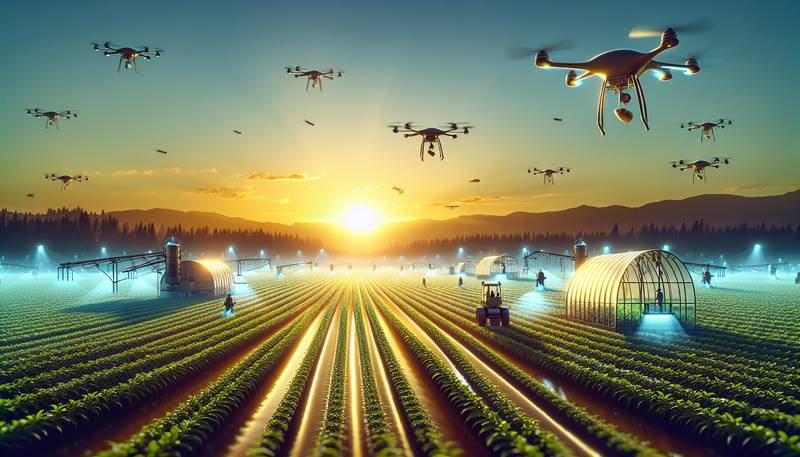Emerging Tech in Agriculture: The Digital Farm of the Future

The world is changing, and with it, the way we farm. Traditional farming methods are slowly being replaced with emerging technology that is not only more efficient but also more sustainable. This shift towards digital farming is revolutionizing agriculture as we know it, and it’s only just beginning. In this article, we will explore the exciting world of digital farming and the emerging technologies that are shaping the industry.
The Rise of Digital Farming
With the world’s population projected to reach 9.7 billion by 2050, the need for more efficient and sustainable farming practices is more critical than ever. Digital farming, also known as precision agriculture or smart farming, is the use of technology to monitor and manage farming operations. By utilizing data and technology, farmers can optimize their processes, reduce waste, and increase yields. As a result, digital farming is quickly becoming the new norm in agriculture.
Emerging Technologies in Digital Farming
Several emerging technologies are driving the digital farming revolution. Some of the most notable include:
Drones
Drones, also known as unmanned aerial vehicles (UAVs), are becoming increasingly popular in agriculture. With their ability to capture high-resolution images and data, drones are used for various purposes, including crop monitoring, irrigation management, and pest control. Drones can cover large areas in a short amount of time, making them an invaluable tool for farmers.
Internet of Things (IoT)
The Internet of Things (IoT) is a network of connected devices that communicate with each other without human intervention. In agriculture, IoT devices include sensors that monitor soil moisture, temperature, and other environmental factors. These devices collect data that help farmers make more informed decisions about planting, watering, and harvesting.
Artificial Intelligence (AI)
Artificial Intelligence (AI) is another promising technology in agriculture. AI can analyze data from drones, IoT devices, and other sources to make predictions and provide recommendations. For example, AI can predict when crops will be ready for harvest or when pests are likely to attack. This technology is helping farmers to be more proactive and efficient in their operations.
Robotics
Robotics is also making its way into agriculture. Robots are being used for various tasks, including planting, harvesting, and packaging. These machines can work tirelessly, day and night, and are not affected by weather conditions. Robots can also perform delicate tasks, such as picking fruits without damaging them, something that is difficult for human workers to do consistently.
The Benefits of Digital Farming
The benefits of digital farming are numerous. By using technology, farmers can:
- Monitor their crops in real-time
- Reduce waste and increase yields
- Minimize their environmental impact
- Save time and money
- Improve the quality of their produce
These advantages are not only good for farmers but also for consumers and the planet. With digital farming, we can produce more food with fewer resources, making it a critical part of the solution to feeding the world’s growing population.
The Challenges of Digital Farming
Despite its many benefits, digital farming also faces several challenges. One of the biggest is the cost of the technology. Many farmers, especially those in developing countries, cannot afford to invest in expensive equipment. Another challenge is the lack of infrastructure, such as reliable internet access, which is necessary for many digital farming technologies to work.
Additionally, there is also the issue of data privacy and security. With so much data being collected and stored, there is a risk of it falling into the wrong hands. Farmers must be vigilant in protecting their data and ensuring that it is used ethically and responsibly.
The Future of Digital Farming
The future of digital farming is bright. As technology continues to advance, we can expect to see even more innovations that will further revolutionize the industry. Some of the most exciting possibilities include:
Vertical Farming
Vertical farming is the practice of growing crops in vertically stacked layers. This method allows for more efficient use of space and resources and can be done indoors, making it possible to farm in urban areas.
Genetically Modified Crops
Genetically modified crops are another area of interest. By altering the genes of plants, we can create crops that are more resistant to pests, disease, and extreme weather conditions. This technology has the potential to significantly increase food production and reduce the need for harmful pesticides.
Blockchain
Blockchain technology is also being explored in agriculture. Blockchain can be used to create secure and transparent supply chains, making it easier to trace the origin of food and ensure its safety.
In conclusion, digital farming is the future of agriculture. With emerging technologies such as drones, IoT, AI, and robotics, farmers can optimize their operations, reduce waste, and increase yields. While there are challenges to overcome, the benefits of digital farming are too great to ignore. As we continue to innovate, we can look forward to a more sustainable, efficient, and productive agricultural industry. The digital farm of the future is not just a dream, it’s becoming a reality.


